
Globo.com’s Live Video Platform for FIFA World Cup ’14- Part II – DVR and Microservices


The following is adapted from a presentation given by Leandro Moreira and Juarez Bochi of Globo.com at nginx.conf 2015, held in San Francisco in September. This blog post is the second of two parts, and is focused on using NGINX to build microservices. The first part, focused on delivery and caching, can be found here. You can watch the video of the complete talk on YouTube.
Table of Contents
19:02 DVR
20:24 DVR Challenges – Failover
21:06 DVR Challenges – Storage
22:11 Redis as a Datastore
23:20 Brazil’s General Election
24:12 From Redis to Cassandra
25:11 Waiting Room
27:40 Waiting Room Architecture
29:02 FIFA 2014 World Cup Results
31:00 Recap and Next Steps
31:58 NGINX + Lua is Amazing
33:17 Open Source Software Development
33:55 Summary and the Future
34:50 Questions and Answers
19:02 DVR
Juarez: By 2013, we were really happy with our infrastructure and the experience that we were delivering, so we started to think about what else we could do for the 2014 World Cup.
One of the features that we decided to develop is DVR. That stands for Digital Video Recording, and it gives the ability to pause the video, go back and, for instance, watch the goal again.
To do DVR with HLS, we just use a larger playlist. You have seen that the playlist is just a text file that lists the segments. For DVR, instead of just a couple of seconds of video, we list the segments for the entire match.
Just to review our solution, we can say that there were two main parts: the ingest and the frontend. And the interface between both of them was the storage; these are the files that we were segmenting and making available for NGINX to deliver.
20:24 DVR Challenges – Failover
So, the storage was a problem because we didn’t have failover. If the stream stopped, then we had to start again. The server that we were using, EvoStream, would just erase the playlist and start a new one.
This is not a problem if you don’t have DVR, because the user will just see a small bump and reconnect again and the stream will continue normally, but if you lose the older playlist, then the user will not be able to seek back. So for DVR, we need to keep all the segments and the playlists.
21:06 DVR Challenges – Storage
We also were a little bit worried about the storage, because for a single stream, a single match, we would split that in several bitrates; six in this case. Each bitrate is a different quality so, depending on the user bandwidth, they can watch one or another. It uses about 4.5 megabytes for 5 seconds of video, so for a two hour game, that would be around 6 gigabytes.
We had two simultaneous games and other streams that our company Globo was broadcasting, so we needed about 40 gigabytes. That’s not too much. We can put it all in RAM, so we decided to go ahead and use Redis as storage for video.
Leandro: We just replaced that older structure where we were saving the data to a folder and now we saving the chunks and HLS files to Redis.
22:11 Redis as a Datastore
Juarez: We built a daemon in Python; a simple script that would monitor the files and move the files as they were segmented to our Redis database. Then we used NGINX with the Lua module to fetch the list of streams from Redis and view the playlist dynamically. It took only a day or two to make that work.
Leandro: It was nice to use Python, but at the same time we found it difficult to scale. I don’t know if it’s because we didn’t have enough experience, but it was not easy for us to scale Python to multiple cores, so the daemon that monitors the file change and saves it to HLS gave us a lot of pain. If we did it again, we might choose another language, but at the time it was the simplest solution, and it’s still working today.
Juarez: Yes. This became a problem, especially when we had the general election in Brazil.
23:20 Brazil’s General Election
So, later, when we were broadcasting Brazil’s general election, we had more than 30 simultaneous streams, one for each state. As Leandro said, the Python script became a bottleneck. And with Redis we also ran into issues since we couldn’t put all of this in memory, so we decided to move from Redis to Cassandra.
And just to clarify – for the World Cup, we were still using Redis. The election happened after, but we thought that was interesting to share here.
24:12 From Redis to Cassandra
We didn’t have to change this daemon much besides dealing with the scalability issues, but on the frontend we had to develop a new driver for Lua. We didn’t find anything at the time available for NGINX, so we had to write one ourselves. Since then more people have used this module, which has been great to see.
25:11 Waiting Room
Another thing that we had to build was a waiting room. We don’t use a CDN, and we have links with several internet providers in Brazil, and we have two data centers.
Sometimes, a user would be watching a video from an ISP that had a low bandwidth connection with us, and that might make the experience worse for everybody in that ISP. So, we decided to build a waiting room – if too many users were watching from the same link, we would put them on a queue.
Leandro: We’ll get into the details about the waiting room in a later slide, but first, we need to talk about our multihoming solution. To make a single IP, the illusion of a single point, we chose to go with anycast.
Anycast works like this: You have the BGP protocol, which announces the routes, and then we have the ISPs. Since we are an internet company, we are an autonomous system so we can exchange data, house data with the company’s ISP.
So we announce a route, and then our ISP will acknowledge that route. Now if you have a group of users near Sao Paulo. When they try to reach a given address, the ISP will wisely route their request to the nearest PoP.
Now we can get more into the waiting room.
Here we can see that ISP Y has a very low bandwidth connection to us so their users will have a poor experience while watching our broadcast. But they will not complain about their ISP, they will tweet about us. This is obviously not ideal, so we came up with the waiting room.
27:40 Waiting Room Architecture
Juarez: Here is the back of the napkin draft that we did. The video player asks if there is room for him, and we would check which route, which link they are coming in from. If that link has enough capacity, we let them through. If not, we put them in a queue.
To check which link they are coming from, we used a fork of Redis that has this new data structure called interval sets and put all the available routes in it. This made it really fast to do a lookup of an IP address to a link. And we also had to build a script that would listen to the BGP protocol and save that data in Redis. But with NGINX and Lua, it was easy to build a microservice that would check this database.
Leandro: And once again, we used NGINX on the frontend to deliver this service.
29:02 FIFA 2014 World Cup Results
I don’t know if you guys like soccer as much as we do, but we were not happy with that result, but that’s life.
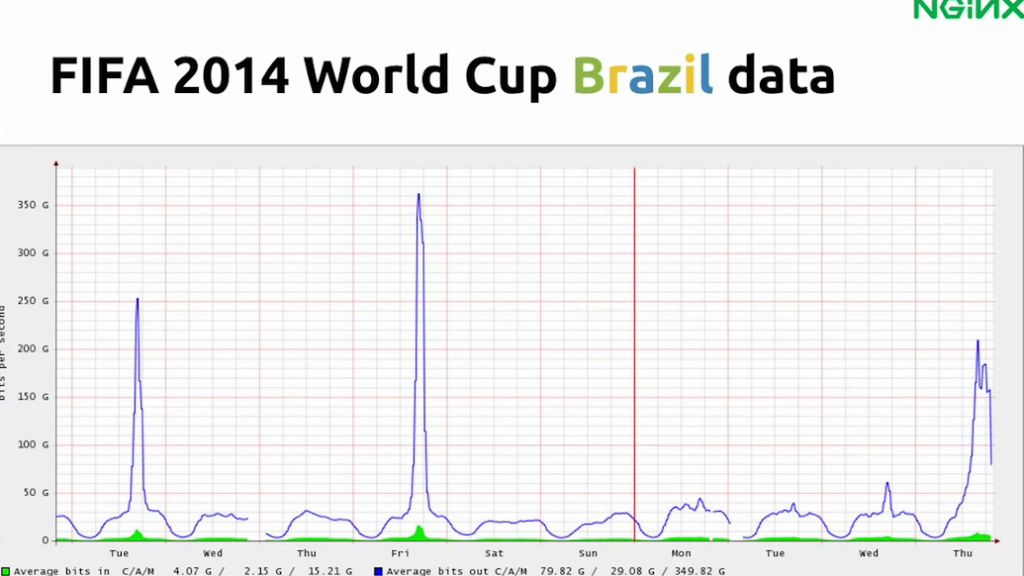
I was very excited with how much bandwidth we could use. This graph shows roughly a few peak points when we had games online. This is not all of the games but I was pretty happy with this result.
We had over 500,000 simultaneous users at one point and could have easily supported more. We expected to have around a million, but we suspect maybe there were less online viewers than expected because when Brazil was playing, people were able to watch the game from their house. So, some people preferred to watch on television especially for the games when we would expect to have the most viewers.
Another cool number is 640 Gbps in one game, which I think is pretty good.
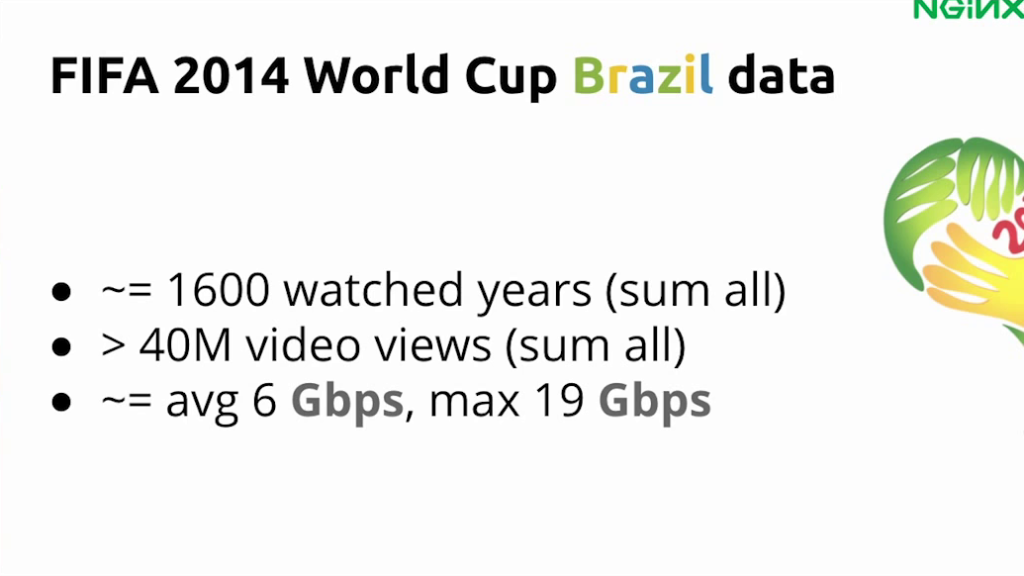
Since we had the Sauron instrumentation, we could estimate using Graphite, that the sum of all the viewing time was roughly 1,600 years. And we also had over 40 million video views.

Here you can see our average bitrates, and one thing that I liked too was that we were able to deliver 20 Gigabits per node using only 10% CPU.
31:00 Recap and Next Steps
Now that we’ve shown you our results, I think it’s time to do a recap and talk about the next steps we think are possible for our platform.
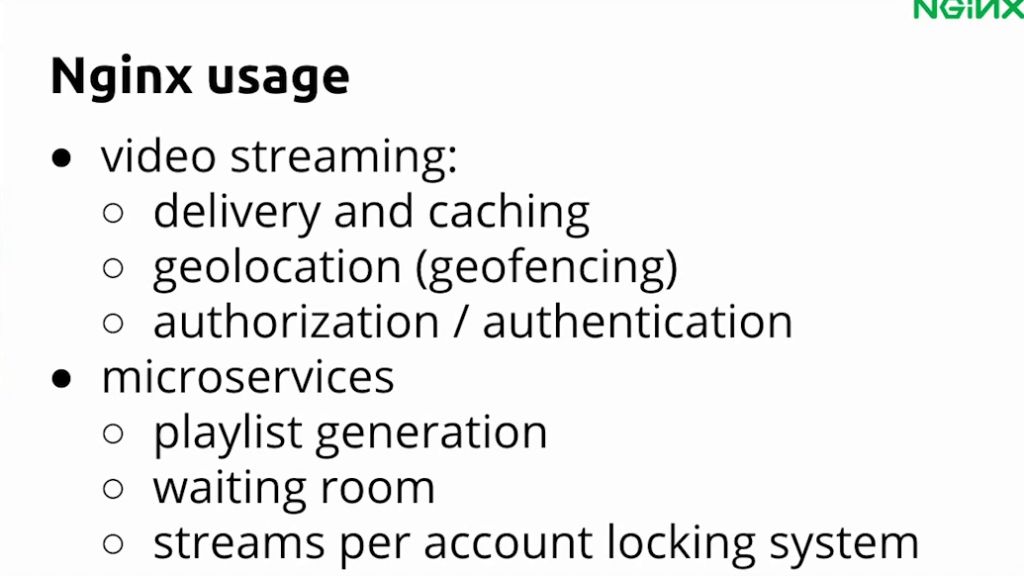
Juarez: We used NGINX a lot for video streaming. We used it for delivery, for caching. We developed modules for geolocation, authorization, authentication.
We also built a lot of our microservices around it. We used NGINX and Lua for playlist generation, for the waiting room. Another system we had which we didn’t have time to mention was the system that locks the amount of concurrent sessions that a single user can have. But this was mostly for closed broadcasts, not for something like the World Cup.
31:58 NGINX + Lua is Amazing
We really love NGINX and Lua. We are excited to try nginScript, but so far we are really happy with Lua. It was made in Brazil but-
Leandro: That’s not relevant!
Juarez: That’s not relevant, haha. I think we should look at the technical side. One model that we tried and we loved is Busted. It works great for test-driven development and made our lives easier.
Lua is a small language so it’s pretty easy to learn. And compared to the C model, we had a much better experience developing with NGINX and Lua. It was much faster to develop in Lua, and you still get a performance near C, so we were really happy with that.
Leandro: It was easier at least for us because we are not C experts.
33:17 Open Source Software Development
One of the cool things we did from that time, was we pushed ourselves to make almost all the software we did open source.
We created this video player called Clappr, which is in production now. We are using it and it’s receiving a lot of support from the community as well. We also made the m3u8 parser, which is the Python script to read the playlist from HLS.
33:55 Summary and the Future
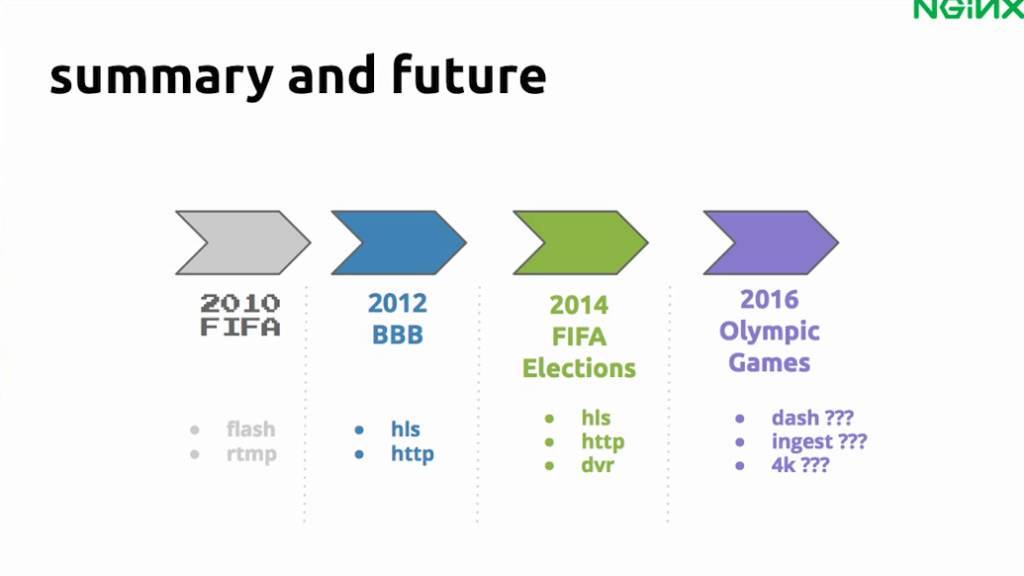
Leandro: In summary, from 2010 to 2014, we transitioned from RTMP to HLS, and then we introduced this feature called DVR.
Now, we’re looking forward to the Olympic Games. We’re thinking of offering different kind of formats like DASH. We will probably change the ingest, the way the signal is ingested, and maybe support 4K.
Juarez: One thing that we know for sure is that we will keep using NGINX.
Leandro: Yes.
34:50 Questions and Answers
1. How many users were watching the match between you and Germany? Do you have any idea?
Juarez: I think after the third goal, none [laughs]. No, just kidding. The audience for the Brazil match was low because everybody was watching on the TV, not on the internet. But it was around 100,000 users.
2. The front-end NGINX server – were those NGINX Plus machines or NGINX open source machines?
Leandro: Open source machines. We were using the community one.
Juarez: Yes. We were using the default open source NGINX solution, and we also had some hardware load balancers that we used to split the load across several instances of NGINX.
3. When you were talking about irqbalance and CPU affinity, how did you realize that there was a problem there?
Juarez: The first thing that we noticed is that we were losing packets; and the second thing that we noticed is that just one core of the machine was in use, and the process that was using the most CPU was the process that was handling the software interrupt for the network cards. So then, we first set the irqbalance to split across some cores, and we found we could have even better performance when we pinned each interrupt to a specific core.
Leandro: It all comes down to the fact that we saw that we have a node capable of 20Gbps, and we were not reaching that 20Gbps, so we thought maybe a problem with NGINX, or a problem with something else, because it’s just serving static files, which shouldn’t be hard. So we started researching, troubleshooting, and we were able to understand and apply those changes that he just talked about.
Juarez: Another interesting number is that with just two NGINX servers, we could handle 100,000 users. That was about what we could get with 50 Flash Media Servers.
The post Globo.com’s Live Video Platform for FIFA World Cup ’14- Part II – DVR and Microservices appeared first on NGINX.
Source: Globo.com’s Live Video Platform for FIFA World Cup ’14- Part II – DVR and Microservices

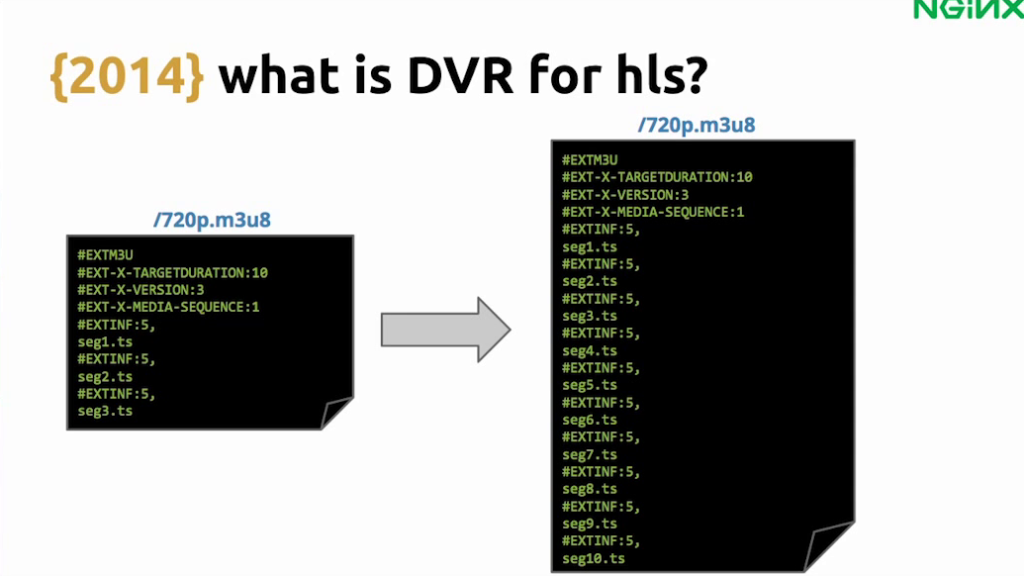



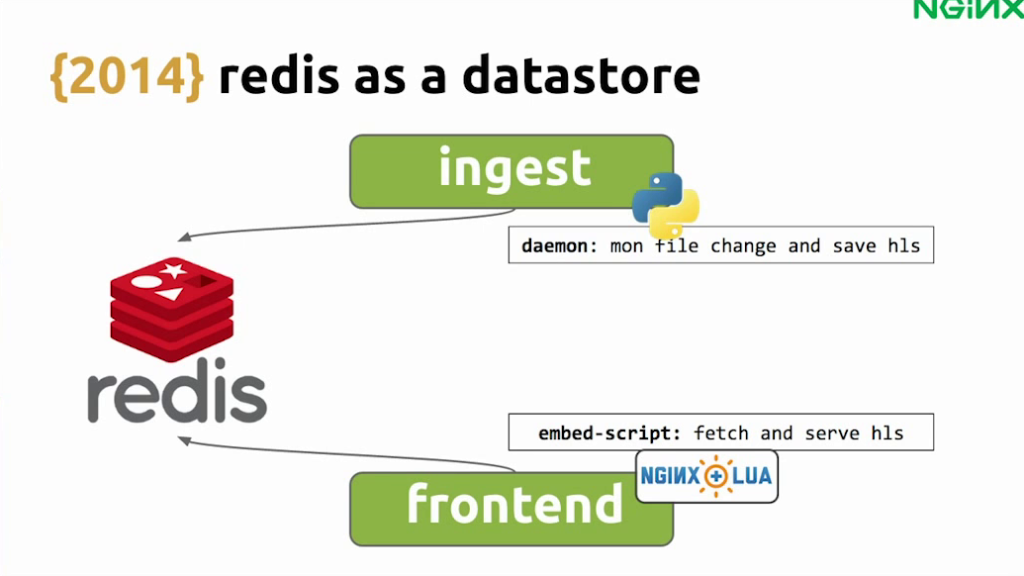
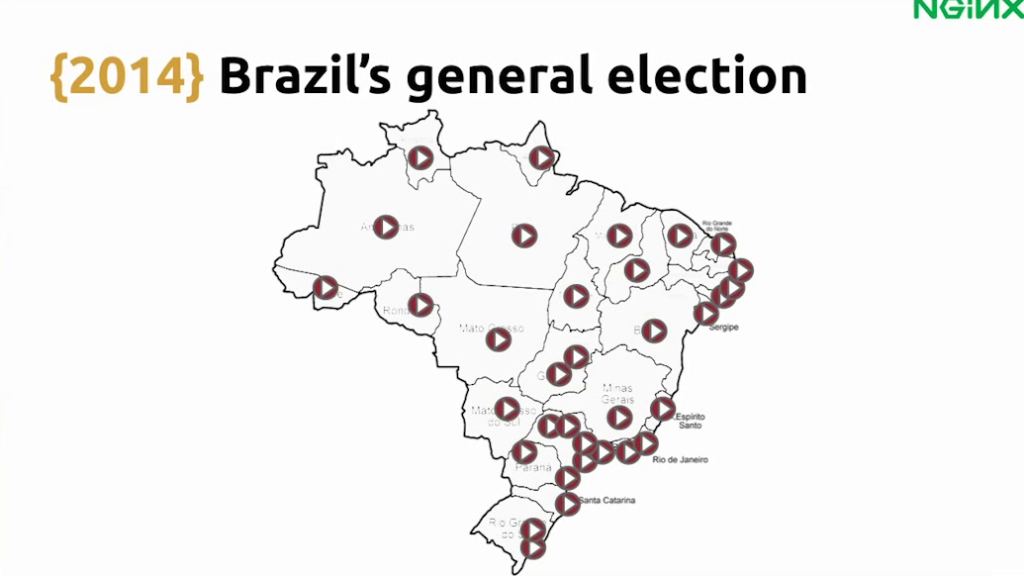
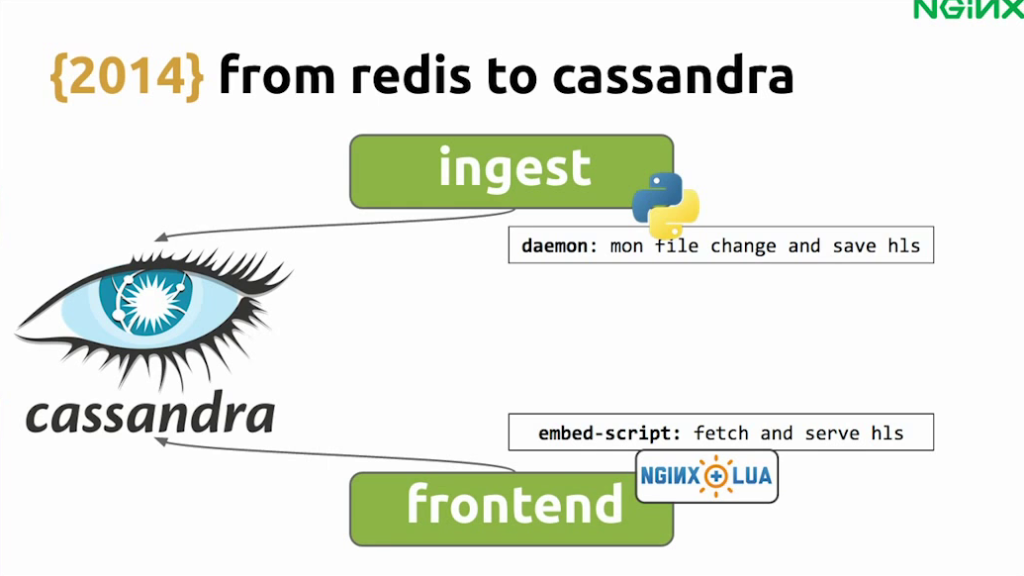
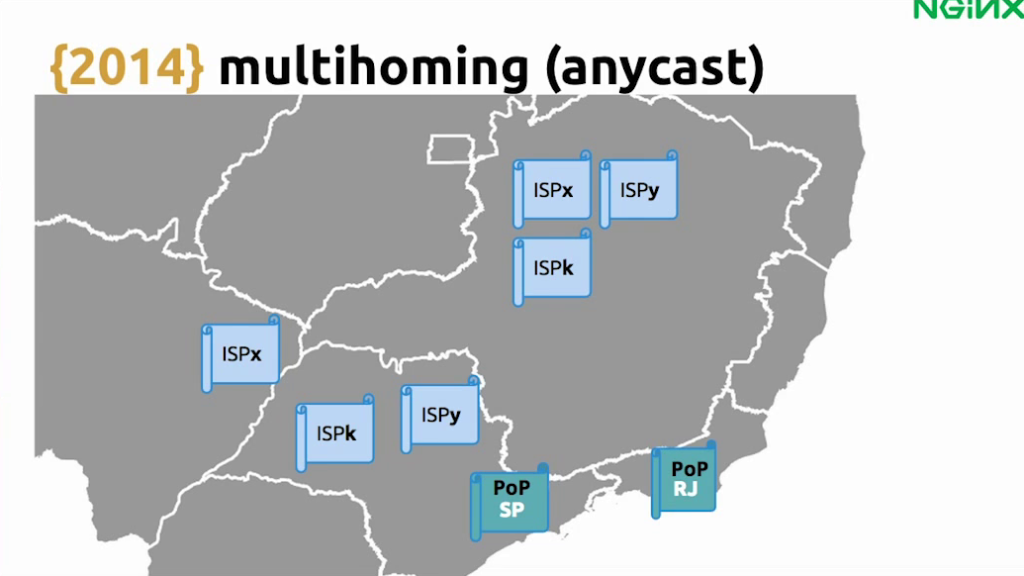

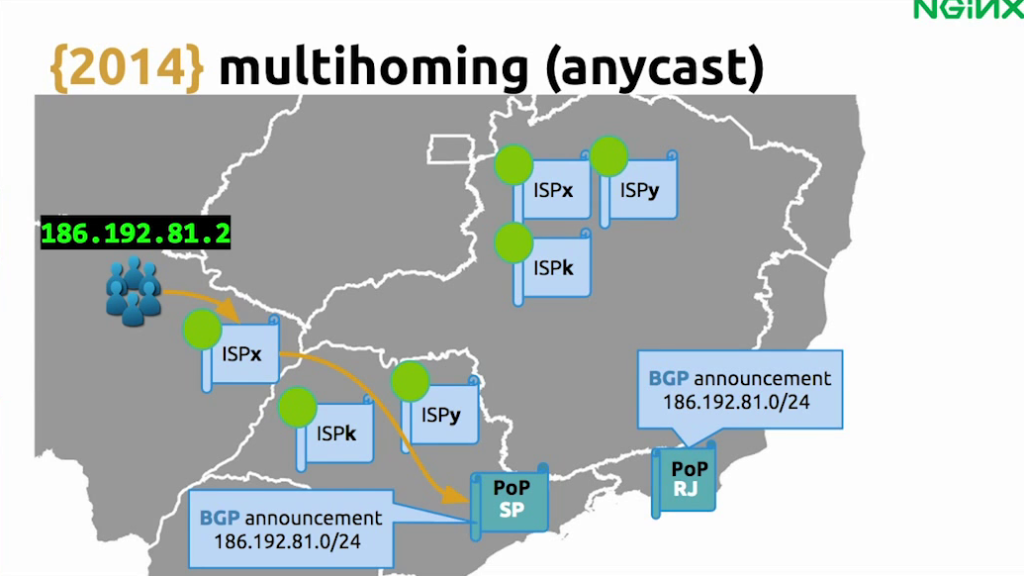
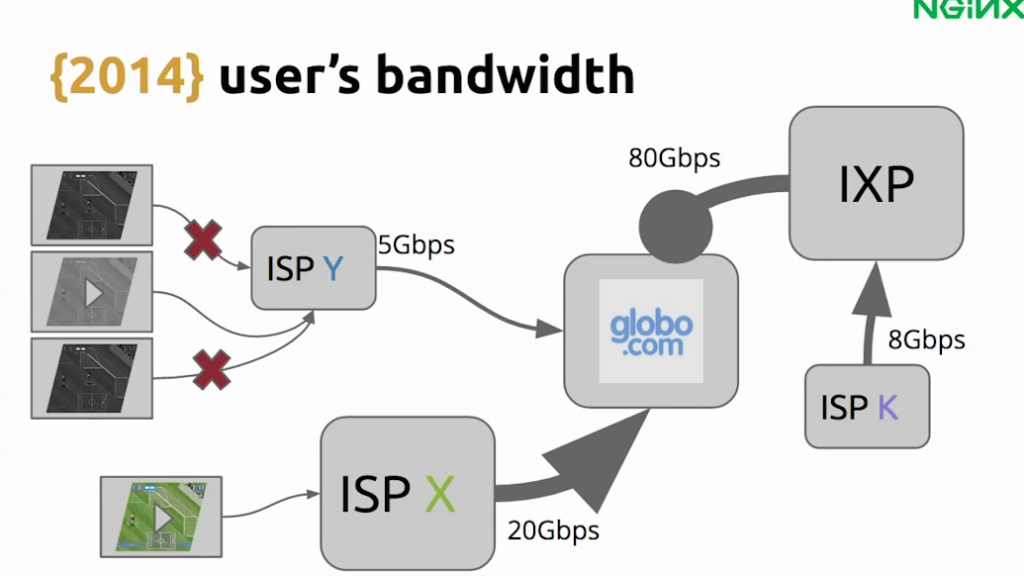



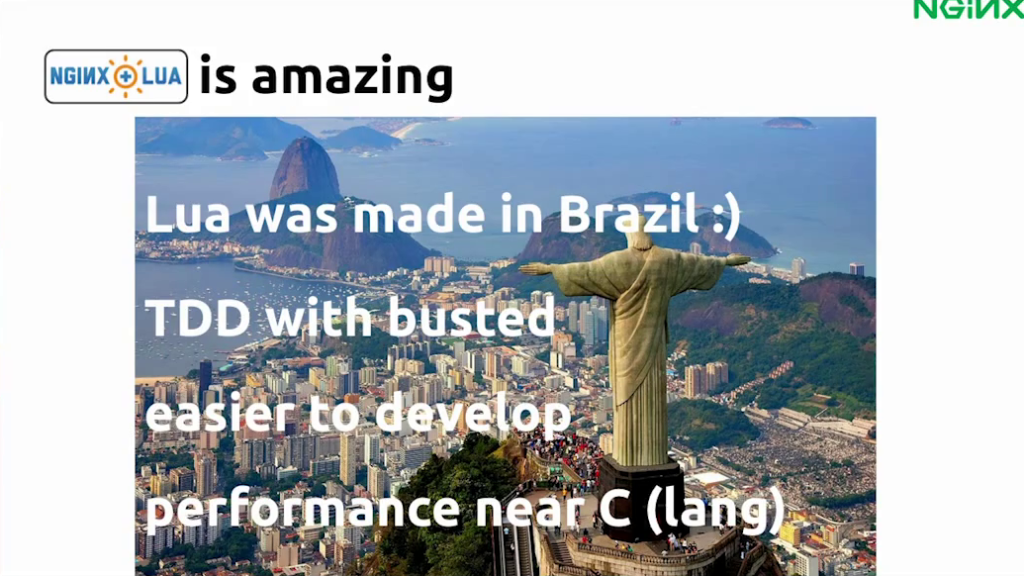
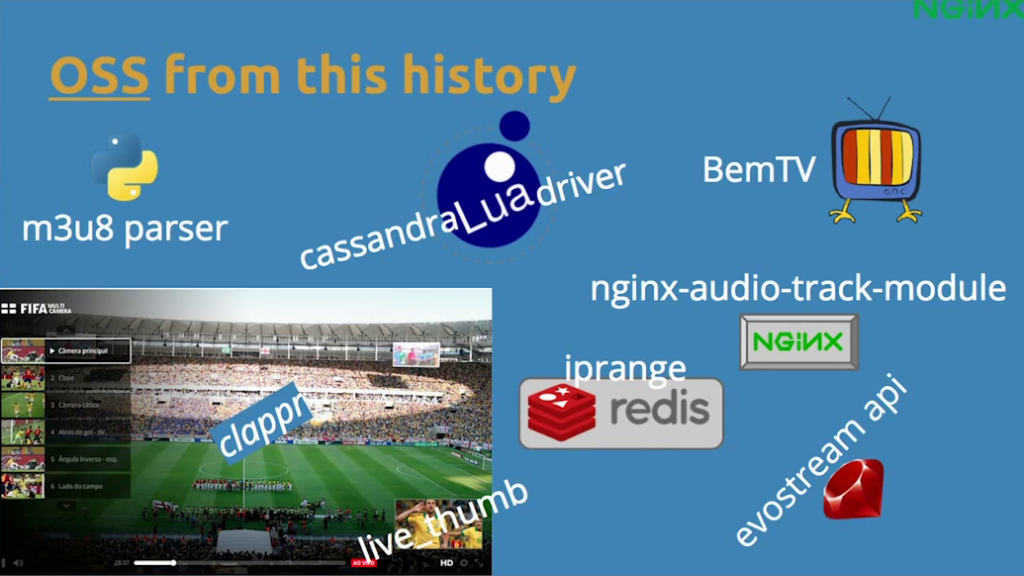





Leave a Reply